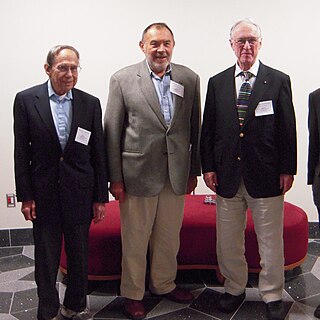
General relativity, also known as the general theory of relativity and Einstein's theory of gravity, is the geometric theory of gravitation published by Albert Einstein in 1915 and is the current description of gravitation in modern physics. General relativity generalizes special relativity and refines Newton's law of universal gravitation, providing a unified description of gravity as a geometric property of space and time or four-dimensional spacetime. In particular, the curvature of spacetime is directly related to the energy and momentum of whatever matter and radiation are present. The relation is specified by the Einstein field equations, a system of second order partial differential equations.

Quantum gravity (QG) is a field of theoretical physics that seeks to describe gravity according to the principles of quantum mechanics. It deals with environments in which neither gravitational nor quantum effects can be ignored, such as in the vicinity of black holes or similar compact astrophysical objects, such as neutron stars as well as in the early stages of the universe moments after the Big Bang.
A wormhole is a hypothetical structure connecting disparate points in spacetime, and is based on a special solution of the Einstein field equations.
In theoretical physics, the Einstein–Cartan theory, also known as the Einstein–Cartan–Sciama–Kibble theory, is a classical theory of gravitation, one of several alternatives to general relativity. The theory was first proposed by Élie Cartan in 1922.
The history of loop quantum gravity spans more than three decades of intense research.
Teleparallelism, was an attempt by Albert Einstein to base a unified theory of electromagnetism and gravity on the mathematical structure of distant parallelism, also referred to as absolute or teleparallelism. In this theory, a spacetime is characterized by a curvature-free linear connection in conjunction with a metric tensor field, both defined in terms of a dynamical tetrad field.
Since the 19th century, some physicists, notably Albert Einstein, have attempted to develop a single theoretical framework that can account for all the fundamental forces of nature – a unified field theory. Classical unified field theories are attempts to create a unified field theory based on classical physics. In particular, unification of gravitation and electromagnetism was actively pursued by several physicists and mathematicians in the years between the two World Wars. This work spurred the purely mathematical development of differential geometry.
In general relativity, Regge calculus is a formalism for producing simplicial approximations of spacetimes that are solutions to the Einstein field equation. The calculus was introduced by the Italian theoretician Tullio Regge in 1961.
In general relativity, the pp-wave spacetimes, or pp-waves for short, are an important family of exact solutions of Einstein's field equation. The term pp stands for plane-fronted waves with parallel propagation, and was introduced in 1962 by Jürgen Ehlers and Wolfgang Kundt.
In general relativity, the hole argument is an apparent paradox that much troubled Albert Einstein while developing his famous field equations.

The Arnowitt–Deser–Misner (ADM) formalism is a Hamiltonian formulation of general relativity that plays an important role in canonical quantum gravity and numerical relativity. It was first published in 1959.

In physics, canonical quantum gravity is an attempt to quantize the canonical formulation of general relativity. It is a Hamiltonian formulation of Einstein's general theory of relativity. The basic theory was outlined by Bryce DeWitt in a seminal 1967 paper, and based on earlier work by Peter G. Bergmann using the so-called canonical quantization techniques for constrained Hamiltonian systems invented by Paul Dirac. Dirac's approach allows the quantization of systems that include gauge symmetries using Hamiltonian techniques in a fixed gauge choice. Newer approaches based in part on the work of DeWitt and Dirac include the Hartle–Hawking state, Regge calculus, the Wheeler–DeWitt equation and loop quantum gravity.

Gravitation is a widely adopted textbook on Albert Einstein's general theory of relativity, written by Charles W. Misner, Kip S. Thorne, and John Archibald Wheeler. It was originally published by W. H. Freeman and Company in 1973 and reprinted by Princeton University Press in 2017. It is frequently abbreviated MTW. The cover illustration, drawn by Kenneth Gwin, is a line drawing of an apple with cuts in the skin to show the geodesics on its surface.

Charles William Misner was an American physicist and one of the authors of Gravitation. His specialties included general relativity and cosmology. His work has also provided early foundations for studies of quantum gravity and numerical relativity.

General Relativity is a graduate textbook and reference on Albert Einstein's general theory of relativity written by the gravitational physicist Robert Wald.
The initial value formulation of general relativity is a reformulation of Albert Einstein's theory of general relativity that describes a universe evolving over time.

In theoretical physics, shape dynamics is a theory of gravity that implements Mach's principle, developed with the specific goal to obviate the problem of time and thereby open a new path toward the resolution of incompatibilities between general relativity and quantum mechanics.
In general relativity, the Hamilton–Jacobi–Einstein equation (HJEE) or Einstein–Hamilton–Jacobi equation (EHJE) is an equation in the Hamiltonian formulation of geometrodynamics in superspace, cast in the "geometrodynamics era" around the 1960s, by Asher Peres in 1962 and others. It is an attempt to reformulate general relativity in such a way that it resembles quantum theory within a semiclassical approximation, much like the correspondence between quantum mechanics and classical mechanics.

Tohru Eguchi was a Japanese theoretical physicist.







